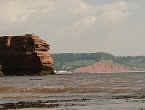East Devon Countryside
 |
 |
 |
| East Devon has some of the most attractive countryside in
Britain. The district is part of the county of Devon in south-west England and covers 315
square miles. It contains a world heritage site as well as habitats of national and
international importance Humans have moulded the landscape which we see today. East Devon features a rolling green countryside and narrow wooded valleys are widely scattered over much of area. The patchwork of irregularly shaped fields are typically bordered by thick hedges. Narrow single track country lanes provide a network of communication although there are many main roads serving the centres of population. The largest town in East Devon is Exmouth which is situated at the mouth of the river Exe. Many of the smaller towns are old market towns and farming is still one of the most important industries. Livestock predominates although on on the drier soils of the south west part of the district there is more arable farming. Much of East Devon is of recognised landscape value and the area contains many designated Sites of Special Scientific Interest (SSSI). A large part of the north of the district is covered by the Blackdown Hills Area of Outstanding Beauty (AONB). The Blackdowns are made up of Upper Greensand and the geology is unique in Britain. To the south, this borders the East Devon AONB which runs down to the coast and English Channel. The coastline is outstanding and is now a natural World Heritage site because of its geology. Red Devon sandstone cliffs to the west contrast with the chalk outcrops which are more prevalent to the east of the district's coastline. Here, there is an area known as the Undercliff which stretches into Dorset. Much of this was formed in December 1839 when a large section of cliff fell down creating the area now known as the Undercliff. Today it is reputed to be Europe's largest self sown Ash forest. In addition to these landscapes, East Devon has several rivers which flow south into the sea. The smallest of these are the river Sid and the river Otter. The Otter estuary is a Site of Special Scientific Interest (SSSI). This a UK designation. The most easterly river is the river Axe which rises at Cheddington in Dorset as a small stream. It runs through the Axe valley for many miles. As it passes through the old roman town of Axminster, which is famous for its carpets, the river valley markedly widens and flattens before exiting into the sea at Axmouth. The Axe estuary is considered to be important from a European perspective and as such is a candidate Special Area of Conservation (SAC). The largest East Devon river is undoubtedly the Exe which runs along much of the west of the district. The Exe has been designated a Ramsar site by the International Convention on Wetlands because of its significance for wildfowl. Lowland Heath is a major landscape feature which is found throughout East Devon. At one time heathland would have stretched over all those areas of East Devon which have greensand soils. Agricultural improvement, forestry, roads and housing have significantly reduced the amount of heathland, nevertheless many heathland areas still exist. The wildlife of the area is as varied as its countryside. Mammals such as roe deer, foxes, badgers and bats are common. The landscape harbours both acidic and chalk soils and thus a variety of habitats are found. The chalk of the Undercliff is famous for its wildflowers as it is for its Peregrine Falcons. The acid boggy heaths are home to insectivorous sundews, whilst the lanes of East Devon are famous for their show of Primroses. In spring, many of the broad-leaved woodlands have spectacular carpets of bluebells. But there is more to East Devon's wildlife than the few species which are mentioned here. This website provides an excellent insight of the world of East Devon's varied wildlife, from fungi to butterflies. You can find out more about East Devon's wildlife, woodlands and heathland here! |
East
Devon Nature |
||
 |
|
| Farming the East Devon Way Courtesy of Quartz Productions |
||
 |
|
Other Local Videos from Quartz Productions